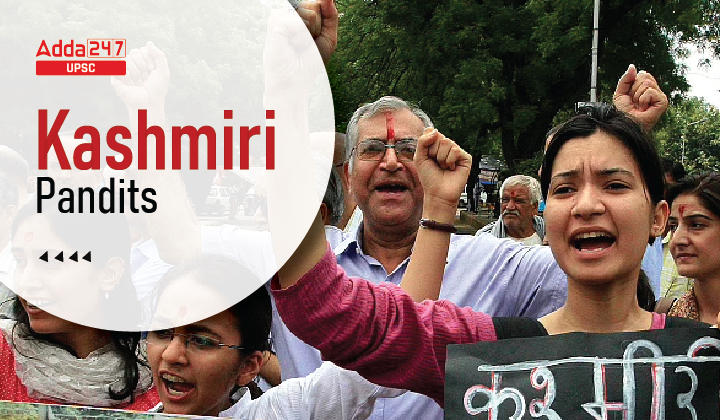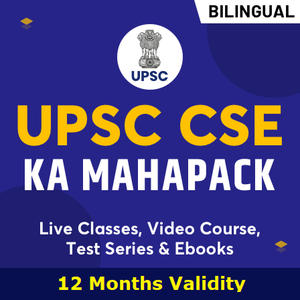Table of Contents
Kashmiri Pandits- Relevance for UPSC Exam
General Studies II- Centre-State Relations.
In News
Recent events of targeted killings of Kashmiri pandits and other Hindus by the militants in the valley lead to the protests which once again brought forward the question of their right to return and the safety of minorities living in the valley.
The Kashmiri Pandits
- The Kashmiri Pandits are one of the highest ranked Brahman castes who are the natives of the valley, locally known as pundits.
- They were the minority in the valley comprising only 5% of the total population.
- Traditionally dependent on agriculture and small-scale business and one of the favored sections in the administration.
The Conflict
- Radical Islamists and militants started targeting the Kashmiri pandits.
- The Growth of militancy in the 1990s forced Kashmiri pandits to leave the valley in greater numbers and thus they started migrating to the other states, leaving every belonging behind and seeking refuge in other parts.
- While many of them started migrating some decided to stay back in their homeland.
- Conflict arose between radical Islamists organization and the Hindus leading to the mass killings of the Kashmiri Hindus in waves.
- After the Pandit exodus from the Valley in the 1990s, the first few years of this century saw government efforts to send Pandits back to the Valley.
- Under the Prime Minister’s return and rehabilitation of Kashmir migrants scheme, government postings in the Valley for Kashmiri Pandit “migrant” youth began.
- Mostly, teachers and these government employees have lived in protected high security enclaves, but their work requires them to leave these enclaves and mingle with the rest of the population.
- Another segment, known as “non-migrant” Pandits because they never left the Valley, has lived in their own homes, without state-provided protection.
What is CDR?
- Centre for dialogue and reconciliation (CDR) is a Delhi-based think-tank incorporated in March 2001, aims to be a catalyst for peace in South Asia.
- CDR working for the peace-building process in Jammu Kashmir, supported the initiative of dialogue between the two communities as a part of self-assessment, acknowledging the mistakes.
What did CDR do in Kashmir?
- CDR supported the initiative for a dialogue proposed by two prominent young Kashmiris one a Muslim and the other a Pandit both who have witnessed the violence of 1990 and the subsequent years.
- They believe in the principle of talking could lead to healing.
- It led to CDR’s ‘Shared Witness’, a Pandit-Muslim dialogue series, in December 2010.
- Public intellectuals and other influential persons from both communities were participants.
Observations of the dialogue
- The dialogue series coincided with the launching of the Prime Minister’s job scheme.
- Dialogues created a social environment that enabled Kashmiri Pandits to take up government postings in the Valley.
- They focused on the events in and around 1990, and the incidents that triggered the displacement of the Pandit community.
- By the third dialogue, participants were sharing individual experiences that did not fit into the narrative that each community had built about the other.
- The process of the conversation led them to think on the actual reason behind the conflict, was it communal differences, or was it only religion?
Pandit’s Plight
- Pandits were aggrieved that the Muslims did not protest the Pandit killings, not even when the killers claimed them. That greater responsibility lay with the Muslims as they were the majority.
- If some social organizations had acted quickly, the exodus could have been stopped.
- They observed that the Pandit community too had suffered from a lack of leadership.
- They demand an apology and to set up of possible “Truth commission”
What do the Muslims say?
- The Muslim participants felt the Pandits were in denial of the struggle of the Muslims in the Valley, who were facing violence from the system.
- The Kashmiri Muslim was always portrayed as being misguided, aided, and abetted by Pakistan.
- The protest in Kashmir was not against religion but against structures of power and oppression.
Current situation
- The fresh spate of targeted killings of Kashmir pandits created an environment of fear and provided a major setback to their rehabilitation in the Kashmir valley.
Way ahead
- We need urgent civil society engagement between communities in Kashmir once again.
- The government can enable it, but individuals and civil society will need to create conditions on the ground. They will have to encourage people to give up the blame game.




 TSPSC Group 1 Question Paper 2024, Downl...
TSPSC Group 1 Question Paper 2024, Downl...
 TSPSC Group 1 Answer key 2024 Out, Downl...
TSPSC Group 1 Answer key 2024 Out, Downl...
 UPSC Prelims 2024 Question Paper, Downlo...
UPSC Prelims 2024 Question Paper, Downlo...




